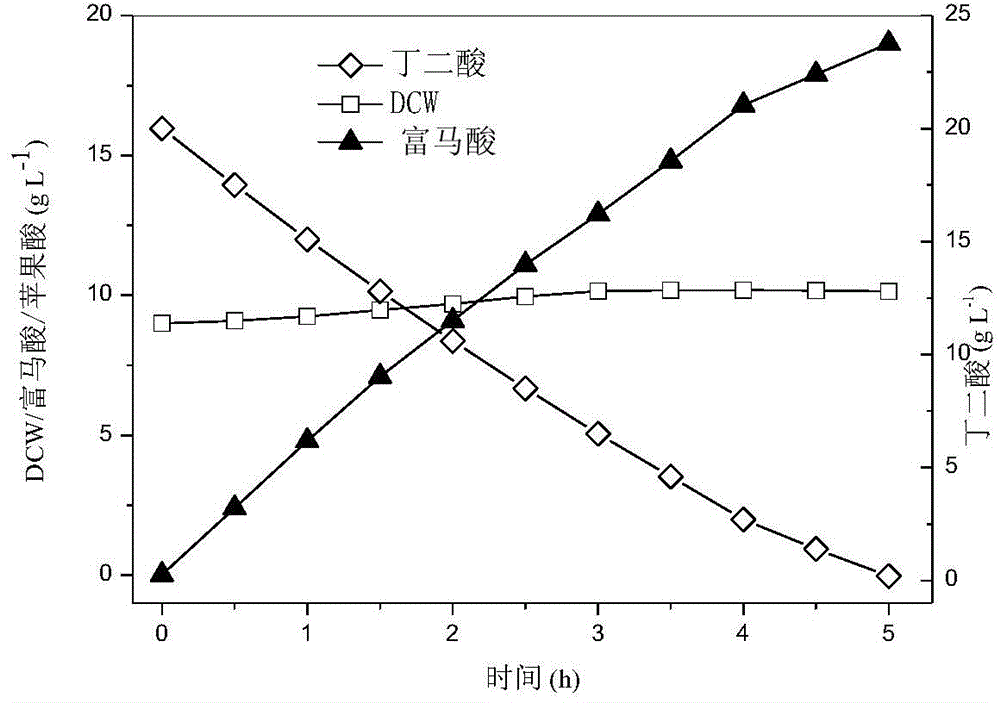Preparation method of succinic acid-producing recombinant escherichia coli cells
A technology of recombinant Escherichia coli and succinic acid production, which is applied in the field of bioengineering, can solve the problems of easy-to-contaminate bacteria, long time and trouble in recycling cells, etc.
- Summary
- Abstract
- Description
- Claims
- Application Information
AI Technical Summary
Problems solved by technology
Method used
Image
Examples
Embodiment 1
[0028] The process of two-stage fermentation acid production adopts the description in the following technical scheme:
[0029] Strain activation: take a small amount of bacterial liquid from a glycerol cryopreservation tube, streak it on an LB plate, and culture it at 37°C for 12 hours; seed liquid preparation: take a single colony from an LB plate, inoculate it in LB liquid medium, and inoculate it in Shake the flask at 37°C and 200r / min until the cell density (OD 600 ) with a value of 0.6.
[0030] Two-stage fermentation: adding glucose to an initial concentration of 25g L -1 , the dissolved oxygen was maintained at 50% during the cultivation process; when the glucose was basically consumed, the CO 2 Gas, enter the stage of anaerobic fermentation acid production, the method of adding glucose at a constant rate during the fermentation process, and control the glucose concentration at 20g L -1 , while intermittently adding basic magnesium carbonate to provide carbon dioxid...
Embodiment 2
[0037] Strain activation: take a small amount of bacterial liquid from a glycerol cryopreservation tube, streak it on an LB plate, and culture it at 37°C for 12 hours; seed liquid preparation: take a single colony from an LB plate, inoculate it in LB liquid medium, and inoculate it in Shake the flask for 8 hours at 37°C and 200r / min until the cell density (OD 600 ) with a value of 0.7.
[0038] Two-stage fermentation: adding glucose to an initial concentration of 20g L -1 , the dissolved oxygen was maintained at 60% during the cultivation process; when the glucose was basically consumed, the CO 2 Gas, enter the acid production stage of anaerobic fermentation, adopt the method of adding glucose at a constant speed during the fermentation process, and control the glucose concentration at 5g L -1 , while intermittently adding basic magnesium carbonate to provide carbon dioxide donors, while adjusting the pH value at 6.4.
[0039] At the end of the fermentation, the bacterial c...
Embodiment 3
[0045] Strain activation: take a small amount of bacterial liquid from a glycerol cryopreservation tube, streak it on an LB plate, and culture it at 37°C for 12 hours; seed liquid preparation: take a single colony from an LB plate, inoculate it in LB liquid medium, and inoculate it in Shake the flask for 8 hours at 37°C and 200r / min until the cell density (OD 600 ) with a value of 0.8.
[0046] Two-stage fermentation: adding glucose to an initial concentration of 30g L -1 , the dissolved oxygen was maintained at 40% during the cultivation process; when the glucose was basically consumed, the CO 2 Gas, enter the stage of anaerobic fermentation acid production, the method of adding glucose at a constant rate during the fermentation process, and control the glucose concentration at 10g L -1 , while intermittently adding basic magnesium carbonate to provide carbon dioxide donors, while adjusting the pH value at 6.8.
[0047] At the end of the fermentation, the bacterial cells a...
PUM
 Login to View More
Login to View More Abstract
Description
Claims
Application Information
 Login to View More
Login to View More - R&D Engineer
- R&D Manager
- IP Professional
- Industry Leading Data Capabilities
- Powerful AI technology
- Patent DNA Extraction
Browse by: Latest US Patents, China's latest patents, Technical Efficacy Thesaurus, Application Domain, Technology Topic, Popular Technical Reports.
© 2024 PatSnap. All rights reserved.Legal|Privacy policy|Modern Slavery Act Transparency Statement|Sitemap|About US| Contact US: help@patsnap.com








